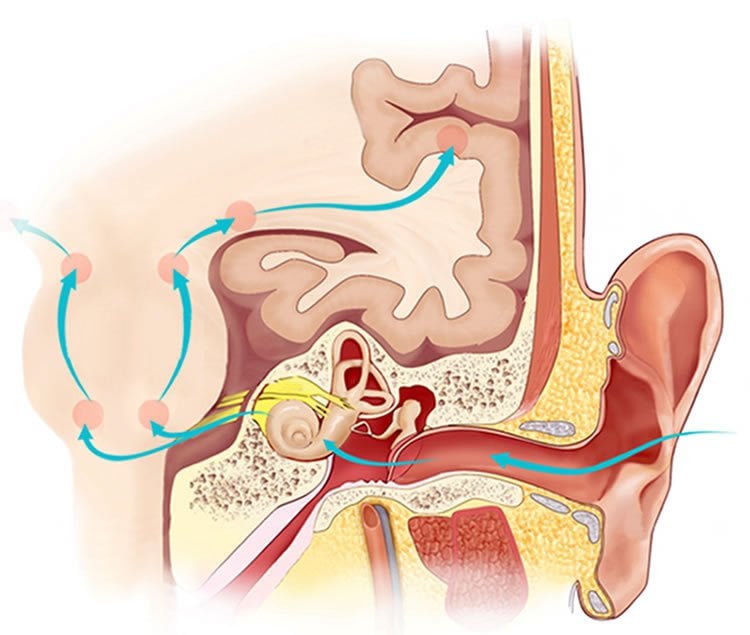Summary: It has often been claimed that exposure to loud noises in recreational activities, such as at a music concert, contributes to hidden hearing loss. New research finds no evidence to support the theory that permanent hearing difficulties occur as a result recreational noise exposure.
Source: Frontiers.
Exposure to loud noises during common recreational activities is widely cited as a cause of “hidden hearing loss.” A new study of young adults, however, finds that while hearing is temporarily affected after attending a loud event, there is no evidence of auditory nerve injury or permanent hearing difficulties. The study is the first to look for a causal relationship between recreational noise exposure and auditory function in humans.
Rodent studies have suggested that loud noises can permanently damage nerve and hair cells in the ear, even if there is no permanent change to threshold sensitivity — that is, is the level below which certain sounds cannot be detected. Such neural injury is often called hidden hearing loss as it cannot be detected by standard hearing tests, which look for a permanent threshold shift.
These studies raised alarm about potential hidden hearing loss in humans — and more recently, whether typical recreational noise can cause such damage.
“The rodent studies serve as the basis for concern that adolescents and young adults may be at risk of neural injury from dance parties, listening to music on personal headphones, and other common activities,” explains Dr Colleen Le Prell, a Professor of Hearing Science at the University of Texas at Dallas, USA. “However, the level of noise exposure in these rodent studies was very high. Later studies with a lower noise exposure showed reduced or no neural injury.”
Given the worrying implications of hidden hearing loss caused by recreational noise, Le Prell and her team assessed neural function and hearing performance in young adults before and after attending a loud recreational event. Different people attended different types of events, which included a concert, a multi-day music festival, a bar with live or electronic music, and a movie. The team also looked for any relationship between the participants’ history of noise exposure in the previous 12 months and their baseline “before” assessments.
The study, published in open-access journal Frontiers in Neuroscience, is the first to prospectively monitor potential hearing change: Previous studies have only examined this retrospectively based on self-reported noise exposure history. In another first, the participants used a smartphone app to measure the sound level during the recreational event. The tests included assessments of middle ear, cochlear and auditory nerve function, determination of the hearing threshold level, and a Words-in-Noise test to evaluate how well the participants could understand speech in background noise.
The team did not find any statistically significant relationship between retrospective recreational noise history and neural function. While a temporary threshold shift was observed within 24 hours of attending the recreational event, the effect was generally small and had disappeared one week later. Similarly, while Words-in-Noise performance was lower one day after the event, there was no significant effect one week later. There was also no evidence of neural injury following the recreational event, either within 24 hours of the event or one week later.
“Despite multiple calls for alarm in the media and in the scientific literature, we found no evidence that typical recreational noise exposure is associated with permanent decreased auditory nerve function or poorer understanding of speech when there is background noise,” says Dr Le Prell.
This does not mean that all recreational loud noise is safe, however. Other studies suggest that firearm users, for example, are almost certainly likely to be at risk for neural injuries.
“We do not know where risk begins in humans for acute recreational noise exposure or for acute high-level exposure,” says Dr Le Prell. “We also do not know how, or if, the risk of injury changes with frequent, repeated noise exposure, such as chronic daily exposure in a loud working environment.”

She advises that anyone experiencing temporary hearing changes or “ringing” in their ears (tinnitus) should protect their hearing in future loud situations.
The study suggests that hearing-in-noise tests may be more sensitive for detecting hearing loss than the current gold standard of testing for permanent threshold shifts.
“If future studies show that hearing-in-noise is the earliest auditory deficit to emerge following exposure to loud noises, then testing for this instead of threshold shifts may allow earlier detection of noise injury,” says Dr Le Prell.
“This is extremely relevant for occupational noise regulations and monitoring. Hearing-in-noise tests may also be more appropriate for measuring the safety of recreational events, as well as for assessing new otoprotective drugs,” she says.
Funding: The work was supported by the Emily and Phil Schepps Professorship in Hearing Science at the University of Texas at Dallas.
Source: Emma Duncan – Frontiers
Image Source: NeuroscienceNews.com image is in the public domain.
Original Research: Full open access research for “Hidden Hearing Loss? No Effect of Common Recreational Noise Exposure on Cochlear Nerve Response Amplitude in Humans” by Sarah K. Grinn, Kathryn B. Wiseman, Jason A. Baker and Colleen G. Le Prell in Frontiers in Neuroscience. Published online September 1 2017 doi:10.3389/fnins.2017.00465
[cbtabs][cbtab title=”MLA”]Frontiers “No Evidence of Hidden Hearing Loss from Common Recreational Noise.” NeuroscienceNews. NeuroscienceNews, 26 September 2017.
<https://neurosciencenews.com/hidden-hearing-loss-7585/>.[/cbtab][cbtab title=”APA”]Frontiers (2017, September 26). No Evidence of Hidden Hearing Loss from Common Recreational Noise. NeuroscienceNews. Retrieved September 26, 2017 from https://neurosciencenews.com/hidden-hearing-loss-7585/[/cbtab][cbtab title=”Chicago”]Frontiers “No Evidence of Hidden Hearing Loss from Common Recreational Noise.” https://neurosciencenews.com/hidden-hearing-loss-7585/ (accessed September 26, 2017).[/cbtab][/cbtabs]
Abstract
Hidden Hearing Loss? No Effect of Common Recreational Noise Exposure on Cochlear Nerve Response Amplitude in Humans
This study tested hypothesized relationships between noise exposure and auditory deficits. Both retrospective assessment of potential associations between noise exposure history and performance on an audiologic test battery and prospective assessment of potential changes in performance after new recreational noise exposure were completed.
Methods: 32 participants (13M, 19F) with normal hearing (25-dB HL or better, 0.25–8 kHz) were asked to participate in 3 pre- and post-exposure sessions including: otoscopy, tympanometry, distortion product otoacoustic emissions (DPOAEs) (f2 frequencies 1–8 kHz), pure-tone audiometry (0.25–8 kHz), Words-in-Noise (WIN) test, and electrocochleography (eCochG) measurements at 70, 80, and 90-dB nHL (click and 2–4 kHz tone-bursts). The first session was used to collect baseline data, the second session was collected the day after a loud recreational event, and the third session was collected 1-week later. Of the 32 participants, 26 completed all 3 sessions.
Results: The retrospective analysis did not reveal statistically significant relationships between noise exposure history and any auditory deficits. The day after new exposure, there was a statistically significant correlation between noise “dose” and WIN performance overall, and within the 4-dB signal-to-babble ratio. In contrast, there were no statistically significant correlations between noise dose and changes in threshold, DPOAE amplitude, or AP amplitude the day after new noise exposure. Additional analyses revealed a statistically significant relationship between TTS and DPOAE amplitude at 6 kHz, with temporarily decreased DPOAE amplitude observed with increasing TTS.
Conclusions: There was no evidence of auditory deficits as a function of previous noise exposure history, and no permanent changes in audiometric, electrophysiologic, or functional measures after new recreational noise exposure. There were very few participants with TTS the day after exposure – a test time selected to be consistent with previous animal studies. The largest observed TTS was approximately 20-dB. The observed pattern of small TTS suggests little risk of synaptopathy from common recreational noise exposure, and that we should not expect to observe changes in evoked potentials for this reason. No such changes were observed in this study. These data do not support suggestions that common, recreational noise exposure is likely to result in “hidden hearing loss”.
“Hidden Hearing Loss? No Effect of Common Recreational Noise Exposure on Cochlear Nerve Response Amplitude in Humans” by Sarah K. Grinn, Kathryn B. Wiseman, Jason A. Baker and Colleen G. Le Prell in Frontiers in Neuroscience. Published online September 1 2017 doi:10.3389/fnins.2017.00465






